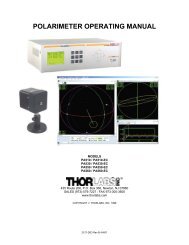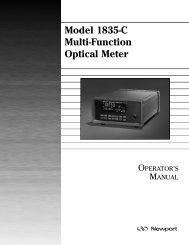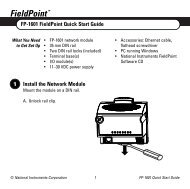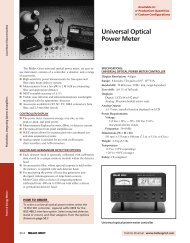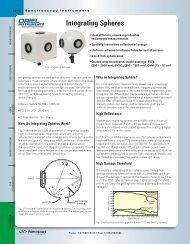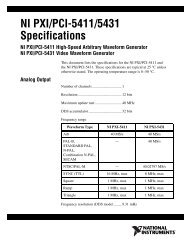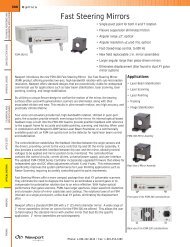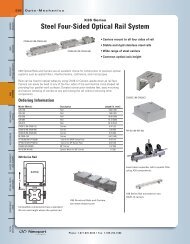(8.5x11) 6000 Manual Cover - Newport Corporation
(8.5x11) 6000 Manual Cover - Newport Corporation
(8.5x11) 6000 Manual Cover - Newport Corporation
Create successful ePaper yourself
Turn your PDF publications into a flip-book with our unique Google optimized e-Paper software.
3.3 Digitized Signal Flow<br />
Signals that are captured by one of the analog-to-digital converters are further<br />
processed as illustrated in the signal flow block diagram of Figure 9. Raw<br />
signals are acquired by the analog-to-digital converters and have the units of<br />
current. These digitized signals move through a number of process steps<br />
which may or may not alter the digitized value depending upon the operating<br />
state of the meter. Each of these possible processing steps is discussed in<br />
their order of occurrence.<br />
Detector<br />
Calib.<br />
Module<br />
Figure<br />
9<br />
DIG<br />
Filter<br />
Gain<br />
ZERO<br />
Responsivity<br />
Map(s)<br />
ZERO<br />
Reference<br />
Front Panel<br />
UNITS<br />
STO-REF<br />
Reference<br />
Remote<br />
Interface<br />
VFD<br />
Display<br />
STATS<br />
Buffer<br />
Data Store<br />
Buffer<br />
Figure 9 – Model 2832-C Digitized Signal Flow Block Diagram<br />
Digital Filter<br />
If the digital filter annunciator DIG is on, Section 2.3.4, the filter output is the<br />
average of the most recent 10 digitized values. When less than 10 values have<br />
been acquired since the last reset of the digital filter, the output is the average<br />
of all the values received. The digital filter is reset when the Model 2832-C is<br />
turned on and whenever the UNITS or the range changes or when the MODE<br />
key is pressed.<br />
NOTE<br />
When using the digital filter in SNGL acquisition mode , each measurement is<br />
the average of the last 10 acquisitions independent of how old any of the<br />
measurements are.<br />
Gain<br />
Gain processing accounts for the signal gain of the input amplifiers. The<br />
output is the product of the digitized value and the amplifier gain.<br />
Zero Offset<br />
Zero offset is active whenever the ZERO annunciator is lit, Section 2.3.5. The<br />
zero offset output is equal to the input value less the zero reference value, S-<br />
S 0<br />
.<br />
26



